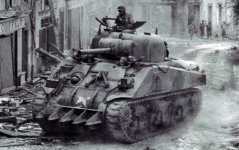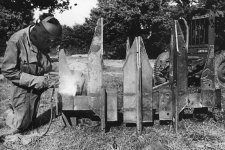BLReed
Sergeant Major
- Joined
- Nov 22, 2009
- Messages
- 1,676

http://www.foxbusiness.com/business-leaders/2015/06/30/american-creativity-helped-win-wwii/
In June of 1944, after American soldiers landed on the beaches of Normandy on D‐Day and moved about ten miles inland, they approached the Normandy countryside the French refer to as the Brocage. This part of France consisted of plots of land that farmers separated with hedgerows rather than fences. The hedgerows were made of two to three feet of packed soil at their base and topped off with several feet of brush and vines.
When the Sherman tanks attempted to go over the top of the hedgerows the front of the tank popped up, exposing its thin underbelly to Nazi anti‐tank fire. As it turns out, Allied military planners had spent so much time planning for the D‐Day landings that they hadn’t fully considered the problems troops might encounter in hedgerow country. The Sherman tanks’ vulnerability caught everyone by surprise.
At first, the Americans tried blasting the hedgerows open so the Sherman tanks could then progress through the holes created by the explosions. Unfortunately, the explosions only served to give the Nazis advance warning of where the tanks were going. Nearly a month after D‐Day, the Allies were falling behind schedule primarily because of the problems created by the hedgerows and the Nazi defense.
One day in a discussion between officers and enlisted men, the idea arose of mounting saw teeth on the front of the Sherman tank. Many of those present laughed at the suggestion. One soldier, however, took the idea seriously. Sergeant Curtis G. Culin, a cab driver from Chicago, immediately designed and built a hedgerow cutting device made from pieces of steel rail that the Nazis had strewn across the beaches to slow down an amphibious attack. When tested, the new device easily sliced through the hedgerows.
It wasn’t long before the Sherman tanks mounted with Culin’s device were branded “Rhinos” by the soldiers because they made a Sherman tank look like a rhinoceros. Within days of testing the Rhinos, the idea was presented to General Omar Bradley, head of the First Army. In short order, he attended a demonstration of the Rhino tank and immediately ordered 500 of Culin’s devices. Within two weeks, sixty percent of the First Army’s Sherman tanks were modified into Rhinos. With the Rhinos the First Army were able to proceed through the hedgerow country in time to crush the Nazi army.


